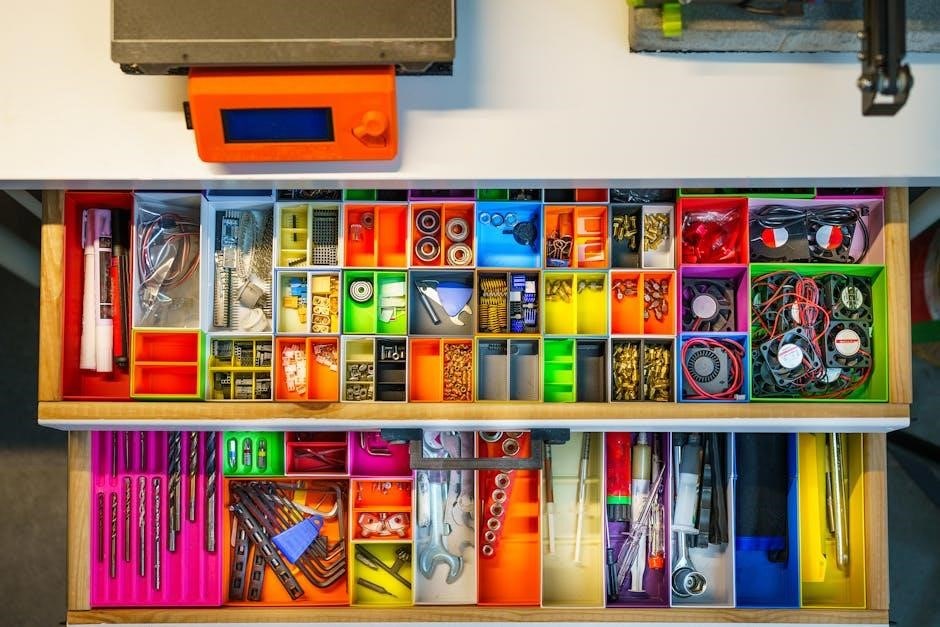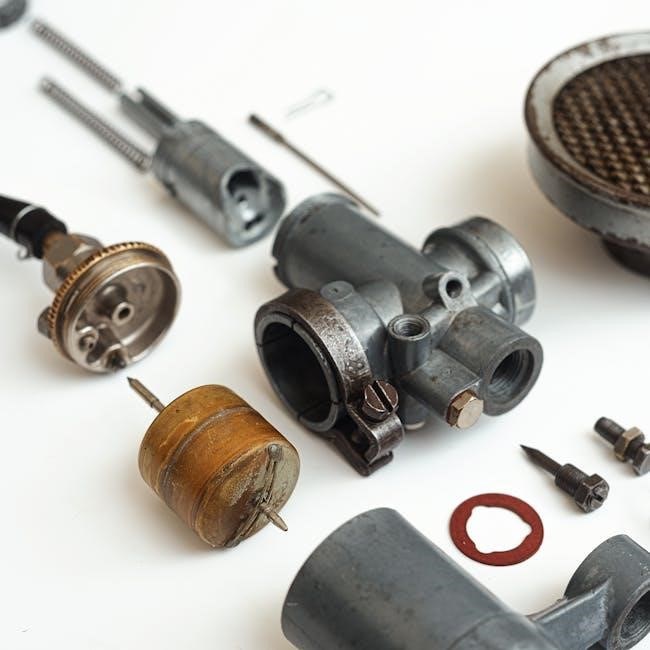chevrolet trax owners manual
Chevrolet provides a comprehensive manual for the 2014 Trax, detailing features and instructions. The manual, version 6014783 from September 23, 2013, covers optional equipment and Chevrolet trademarks.
Overview of the Vehicle
The 2014 Chevrolet Trax owner’s manual (GMNA-Localizing-Canada/Mexico-6014783) serves as a vital guide for understanding your vehicle. It details features potentially differing based on optional equipment. Chevrolet trademarks, including the Chevrolet emblem and Trax name, are protected.
This manual offers crucial instructions and information, though not all features may be present on every vehicle. It’s a resource for safe and effective operation, covering everything from basic functions to more complex systems. The manual is a key component of responsible vehicle ownership, ensuring a positive driving experience.
Importance of the Owner’s Manual
The Chevrolet Trax owner’s manual is paramount for maximizing vehicle enjoyment and safety. It provides detailed instructions, clarifying features and operation, acknowledging potential variations due to optional equipment. Understanding Chevrolet’s trademarks, like the emblem and “Trax,” is also covered.
This manual isn’t just a guide; it’s a resource for responsible ownership. It ensures drivers are aware of all vehicle capabilities and limitations. Referencing it proactively can prevent issues and promote safe driving habits. Familiarity with the manual is essential for a fulfilling ownership experience.

Understanding Your Vehicle
Chevrolet’s 2014 Trax owner manual (GMNA-Localizing-Canada/Mexico- 6014783) provides crucial details about your vehicle, aiding comprehensive understanding.
Vehicle Identification Number (VIN) Location
Locating your Vehicle Identification Number (VIN) is essential for various services, including warranty claims and accessing specific vehicle information. The 2014 Chevrolet Trax owner’s manual doesn’t explicitly detail the VIN location, but generally, it can be found on the driver’s side dashboard, visible through the windshield.
Additionally, the VIN is typically located on the driver’s side doorjamb sticker and within the vehicle’s registration and insurance documents. Knowing your VIN allows access to Technical Service Bulletins (TSBs) and ensures accurate parts ordering during maintenance or repairs; Always refer to official Chevrolet resources for precise details.
Key Components and Their Functions
The 2014 Chevrolet Trax owner’s manual comprehensively details key vehicle components. Chevrolet trademarks like the Chevrolet emblem and Trax name are noted throughout. While the manual covers features potentially varying with optional equipment, core systems are explained.
These include the engine, transmission, braking system, and steering mechanisms. The manual provides basic operational instructions, though detailed repair procedures require professional expertise. Understanding these components is crucial for safe operation and routine maintenance. Refer to the manual for specific details regarding your vehicle’s configuration.
Operating Your Vehicle
The Chevrolet Trax owner’s manual provides essential operating instructions. It details starting, stopping, and understanding features, ensuring safe and informed vehicle use.
Starting and Stopping the Engine
The Chevrolet Trax owner’s manual offers detailed guidance on engine operation. It explains the proper procedures for starting the engine, emphasizing safety precautions and necessary system checks. The manual also outlines the correct method for stopping the engine, ensuring it’s done securely to prevent potential issues.
Furthermore, it details what to expect during the starting and stopping processes, including normal sounds and indicator light behavior. The manual may also cover specific considerations for cold weather starting or emergency situations, providing comprehensive instructions for all conditions. Always refer to your specific manual for accurate details.
Driving Modes and Their Usage
The Chevrolet Trax owner’s manual details available driving modes, if equipped, and explains their specific functions. It clarifies when to utilize each mode – such as Normal, Sport, or Snow/Ice – to optimize performance and safety based on road conditions. The manual provides insights into how each mode alters the vehicle’s responsiveness, traction control, and stability systems.
Additionally, it outlines the benefits of each mode, helping drivers select the most appropriate setting for their current driving scenario. The manual emphasizes that understanding these modes enhances the driving experience and contributes to fuel efficiency. Refer to your manual for specific mode availability.
Fueling and Fluid Checks
The Chevrolet Trax owner’s manual provides detailed guidance on proper fueling procedures, including fuel type recommendations and safety precautions. It outlines how to locate and open the fuel door, and emphasizes the importance of using the correct octane rating. The manual also details how to check essential fluid levels, such as engine oil, coolant, brake fluid, and windshield washer fluid.
Furthermore, it illustrates the location of dipsticks and reservoirs, and explains how to accurately read fluid levels. The manual stresses the significance of maintaining proper fluid levels for optimal vehicle performance and longevity. Regular checks, as outlined in the manual, prevent potential damage.

Safety Features
The Chevrolet Trax owner’s manual details the airbag system, seatbelt usage, and proper child safety seat installation for passenger protection.
Airbag System Details
The 2014 Chevrolet Trax owner’s manual provides crucial details regarding the vehicle’s airbag system. It explains the various airbag locations – frontal, side-impact, and curtain airbags – and their deployment characteristics. The manual emphasizes that airbags are supplemental restraints and function with seatbelts, not as replacements.
It also outlines situations where airbags will and will not deploy, clarifying potential misunderstandings. The manual stresses the importance of never placing objects in front of airbags and cautions against modifying the airbag system. Proper understanding of these details, as outlined in the manual, is vital for safety.
Seatbelt Usage and Maintenance
The 2014 Chevrolet Trax owner’s manual strongly emphasizes the critical importance of proper seatbelt usage for all occupants. It details how to correctly position seatbelts across the hips and shoulder, avoiding loose or twisted straps. The manual also provides guidance on seatbelt use for children, referencing appropriate child safety seat installation procedures.
Regarding maintenance, the manual instructs owners to regularly inspect seatbelts for damage – fraying, cuts, or malfunctioning buckles. It advises against using harsh chemicals for cleaning and outlines procedures for replacing damaged components. Following these guidelines, as detailed in the manual, ensures optimal seatbelt performance.
Child Safety Seat Installation
The 2014 Chevrolet Trax owner’s manual dedicates specific sections to the safe and correct installation of child safety seats. It stresses the importance of adhering to all state and local laws regarding child restraint systems. The manual details LATCH (Lower Anchors and Tethers for Children) system locations within the vehicle, providing clear diagrams for proper attachment.
It also explains how to secure child seats using the vehicle’s seatbelts, emphasizing the need for a snug fit. The manual advises consulting both the car seat manufacturer’s instructions and the Chevrolet Trax manual for compatibility and optimal safety. Proper installation, as outlined, is crucial for child passenger protection.

Infotainment and Technology
The Chevrolet Trax owner’s manual details the Chevrolet Infotainment 3 System, Bluetooth pairing, and smartphone integration via Apple CarPlay/Android Auto.
Chevrolet Infotainment 3 System
The Chevrolet Infotainment 3 System, as detailed in the owner’s manual, provides a central hub for vehicle functions and connectivity. It supports touchscreen control, voice recognition, and customizable settings for a personalized user experience.
The manual explains how to navigate the system’s menus, adjust audio settings, and access various applications. It also covers features like vehicle diagnostics and available apps. Understanding the system’s capabilities enhances the driving experience and allows owners to fully utilize the technology integrated into their 2024/2025 Chevrolet Trax.
Bluetooth Pairing and Connectivity
The owner’s manual provides detailed steps for pairing Bluetooth devices with the Chevrolet Trax’s infotainment system. It explains how to initiate pairing mode on both the vehicle and the external device, ensuring a secure connection for hands-free calling and audio streaming.
The manual also addresses troubleshooting common connectivity issues, such as failed pairing attempts or intermittent disconnections. It emphasizes the importance of following the outlined procedures for optimal performance and a seamless wireless experience. Successful Bluetooth integration enhances convenience and safety while driving.
Smartphone Integration (Apple CarPlay/Android Auto)
The Chevrolet Trax owner’s manual details the process of connecting smartphones via Apple CarPlay and Android Auto. It guides users through the necessary cable connections and system settings to enable seamless integration with the vehicle’s infotainment display.
The manual clarifies compatible smartphone versions and outlines troubleshooting steps for connection problems. It explains how to access smartphone features like navigation, music, and communication through the vehicle’s interface, promoting safer driving by minimizing distractions. Proper setup ensures a user-friendly and integrated driving experience.

Maintenance and Care
The Chevrolet Trax owner’s manual outlines a recommended maintenance schedule, tire pressure monitoring system (TPMS) details, and fluid level checking procedures for optimal vehicle health.
Recommended Maintenance Schedule
The 2014 Chevrolet Trax owner’s manual details a crucial maintenance schedule for longevity. Regular inspections are vital, covering fluid levels, tire conditions, and essential components. Chevrolet emphasizes adherence to these guidelines to maintain performance and safety.
Specific intervals are outlined for oil changes, filter replacements, and brake system checks. The manual also highlights the importance of seasonal maintenance, such as winter tire installation and coolant system inspections. Following this schedule ensures your Trax remains reliable and efficient, preventing potential issues and costly repairs down the road.
Tire Pressure Monitoring System (TPMS)
The Chevrolet Trax owner’s manual explains the function of the Tire Pressure Monitoring System (TPMS). This system actively monitors air pressure in each tire, alerting the driver to potentially unsafe conditions. A warning light illuminates on the dashboard if pressure drops significantly in one or more tires.
The manual stresses the importance of regularly checking tire pressure manually, even with TPMS active. Proper inflation improves fuel efficiency, extends tire life, and enhances vehicle handling. Resetting the TPMS after inflation adjustments is also detailed within the manual’s instructions.
Fluid Levels and Refilling Procedures
The Chevrolet Trax owner’s manual provides detailed guidance on checking and maintaining essential fluid levels. This includes engine oil, coolant, brake fluid, power steering fluid, and windshield washer fluid. The manual specifies the correct fluid types for your Trax, preventing damage from incompatible products.
It outlines step-by-step procedures for safely checking each fluid’s level using the dipsticks or reservoir markings. The manual also explains the proper refilling techniques, emphasizing not to overfill. Regular fluid checks, as described, are crucial for optimal vehicle performance and longevity.

Troubleshooting Common Issues
The Chevrolet Trax owner’s manual details jump-starting, flat tire procedures, and interpreting warning lights. It assists owners in addressing typical vehicle problems effectively.
Jump Starting Procedures
The Chevrolet Trax owner’s manual provides detailed jump-starting instructions for a discharged battery. It emphasizes safety precautions, including wearing eye protection and ensuring proper cable connection order – positive to positive, negative to ground. The manual advises against jump-starting if the battery is cracked or leaking.
It stresses using jumper cables of adequate gauge and avoiding contact between clamps. The procedure involves connecting the cables to a known good battery, starting the assisting vehicle, then attempting to start the Trax. Following these steps carefully, as outlined in the manual, minimizes risk and maximizes success.
Dealing with a Flat Tire
The Chevrolet Trax owner’s manual details a step-by-step procedure for changing a flat tire, prioritizing safety. It instructs drivers to pull over to a safe, level surface away from traffic and activate hazard lights. The manual outlines locating the spare tire, jack, and lug wrench, emphasizing proper tool usage.
It provides clear instructions on loosening lug nuts before jacking up the vehicle, positioning the jack correctly, and fully removing the flat tire. After installing the spare, the manual stresses tightening lug nuts in a star pattern and checking tire pressure. Remember to consult the manual for torque specifications.
Warning Lights and Their Meanings
The Chevrolet Trax owner’s manual dedicates a section to interpreting the instrument panel’s warning lights. It categorizes lights by severity – critical, warning, and informational – explaining each symbol’s meaning. The manual details what action to take when a light illuminates, ranging from immediate stops for critical warnings to monitoring the system for informational lights.
It covers lights for engine issues, low fuel, tire pressure, airbag systems, and braking systems. The manual emphasizes that ignoring warning lights can lead to vehicle damage or safety hazards. Always refer to the manual for a complete understanding of each indicator.

Technical Service Bulletins (TSBs)
Chevrolet releases TSBs for the Trax, addressing known issues. Owners can access these PDF documents by vehicle make, model, and year for detailed repair instructions.
Accessing and Understanding TSBs
Technical Service Bulletins (TSBs) are crucial resources for Chevrolet Trax owners. These bulletins, often available as PDF downloads, detail known issues and recommended repair procedures. Accessing TSBs involves searching by vehicle make, model, and year on Chevrolet’s official support website.
Understanding a TSB requires attention to detail; it outlines the problem, the cause, and the specific steps for resolution. While TSBs aren’t recalls, they provide valuable insight into common vehicle concerns. Owners can use this information to discuss potential issues with their service technician, ensuring informed repairs and optimal vehicle performance.
Common TSBs for the Chevrolet Trax
While specific TSBs vary by model year, the 2022 Chevrolet Silverado 1500 had documented TSBs available for download in PDF format. Though focused on the Silverado, this illustrates the type of information owners can find. For the Trax, common TSBs often relate to the infotainment system, including Bluetooth pairing issues and smartphone integration glitches (Apple CarPlay/Android Auto).
Other frequent TSBs address minor powertrain concerns or sensor malfunctions. Regularly checking for updates is vital, as Chevrolet continually releases new bulletins to address emerging issues. Owners should consult official Chevrolet resources for the most accurate and up-to-date information.

Warranty Information
Chevrolet offers a new vehicle warranty; details are crucial for owners. Procedures for filing a warranty claim are outlined, ensuring proper coverage and service.
New Vehicle Warranty Details
Chevrolet provides a comprehensive warranty for the 2024/2025 Trax, offering peace of mind to new vehicle purchasers. This warranty typically includes coverage for defects in materials or workmanship for a specified period. The bumper-to-bumper warranty generally covers a duration of 3 years or 36,000 miles, whichever comes first.
Additionally, the powertrain warranty extends coverage for vital engine and transmission components, often lasting 5 years or 60,000 miles. Corrosion protection is also included, safeguarding against rust-through. Owners should consult their specific warranty booklet for precise terms, conditions, and exclusions. Maintaining proper vehicle maintenance is essential to uphold warranty validity.
Warranty Claim Procedures
Chevrolet streamlines the warranty claim process for Trax owners. Initially, contact your authorized Chevrolet dealership’s service department to report the issue and schedule an appointment. A qualified technician will diagnose the problem and determine if it’s covered under warranty.
The dealership will then submit the claim to Chevrolet for approval. Keep detailed records of all service visits, including dates, descriptions of the issue, and repair orders. If a claim is denied, you have the right to appeal the decision through Chevrolet’s customer assistance center. Refer to your owner’s manual for specific contact information.

Chevrolet Forums and Online Resources
Chevrolet enthusiasts actively participate in online forums, like Chevrolet Forum, offering support and discussions. Online owner manuals and resources are readily available.
Popular Chevrolet Trax Forums
Chevrolet owners frequently utilize online forums to connect, share experiences, and seek assistance with their vehicles. The Chevrolet Forum ⏤ Chevy Enthusiasts Forums is a prominent platform, offering a space for discussions, news, and how-to guides.
Specifically, forums dedicated to Silverado, Sierra, and full-size pick-ups provide valuable insights. Additionally, sections for 2007-2013 (GMT900) trucks cater to owners of those models. These communities often discuss technical issues, including Technical Service Bulletins (TSBs), and offer support related to owner’s manual information.
Online Owner Manuals and Support
Chevrolet provides digital access to owner manuals and support resources. Finding answers to questions not covered in the physical 2014 Trax owner’s manual is often possible online. Resources include access to Technical Service Bulletins (TSBs) categorized by vehicle make, model, and year, available as PDF downloads.
These TSBs, like the 2022 Silverado 1500 bulletin, address specific issues and offer solutions. Chevrolet’s official website and enthusiast forums also offer assistance, fostering a community-driven support network for Trax owners seeking guidance.

Specifics of the 2014 Chevrolet Trax Owner Manual
Chevrolet TRAX’s 2014 owner manual (GMNA-Localizing-Canada/Mexico- 6014783) includes trademark information and details features, potentially varying by vehicle configuration.
Blackplate Information and Manual Version
The 2014 Chevrolet Trax Owner Manual prominently features “Blackplate(1,1)” on page one, signifying a specific formatting or identification element within the document’s production process. This manual is identified by the part number GMNA-Localizing-Canada/Mexico- 6014783, a crucial identifier for ensuring owners have the correct documentation for their vehicle.
The manual was officially released on September 23, 2013, and is designated for the 2014 model year Chevrolet Trax. Understanding this version information is vital when referencing technical service bulletins or seeking support, as updates and revisions may occur in subsequent editions.
Trademark Information
The Chevrolet Trax Owner Manual explicitly states that CHEVROLET, along with the iconic CHEVROLET Emblem, and the vehicle name TRAX itself, are registered trademarks and/or service marks owned by Chevrolet Motor Division. This declaration underscores the brand’s legal protection of its identity and intellectual property.
Owners should be aware of these trademarks when discussing or referencing the vehicle or its components. The manual also notes that Chevrolet Motor Division retains all rights to these marks wherever they appear within the documentation, reinforcing their exclusive ownership and usage rights.
Optional Features and Manual Coverage
The 2014 Chevrolet Trax Owner Manual acknowledges that not all features described within its pages will be present on every vehicle. This is due to the availability of various optional equipment packages and configurations offered at the time of purchase.
The manual is designed to be a comprehensive guide, covering a wide range of possibilities. Owners are advised to consult their vehicle’s specific equipment list to determine which features are actually installed. This ensures accurate understanding and proper operation of their individual Chevrolet Trax.











































































